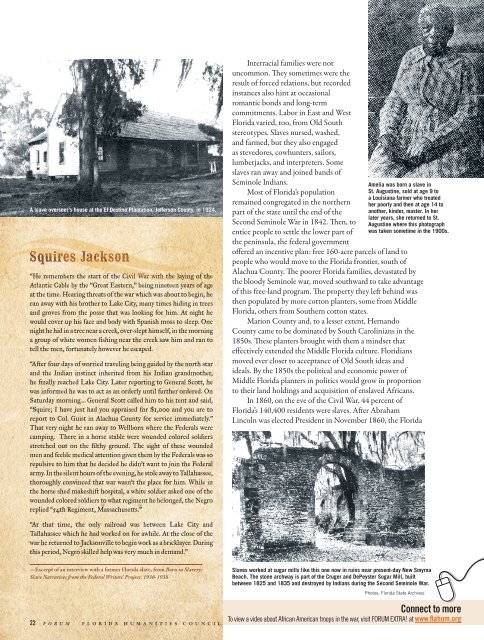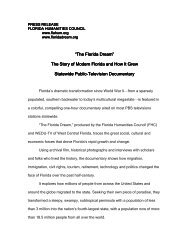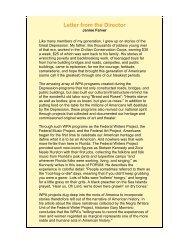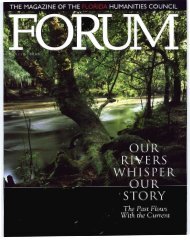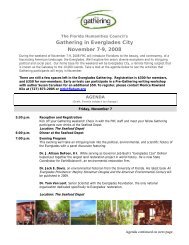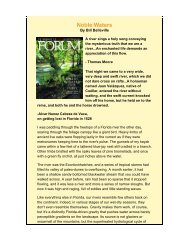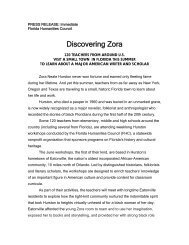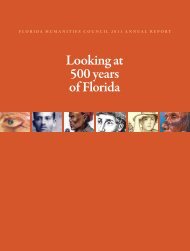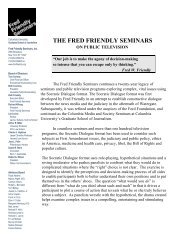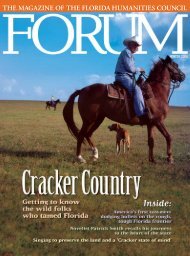when florida “Opened up the gates of hell” - Florida Humanities ...
when florida “Opened up the gates of hell” - Florida Humanities ...
when florida “Opened up the gates of hell” - Florida Humanities ...
You also want an ePaper? Increase the reach of your titles
YUMPU automatically turns print PDFs into web optimized ePapers that Google loves.
A slave overseer’s house at <strong>the</strong> El Destino Plantation, Jefferson County, in 1924.<br />
Squires Jackson<br />
“He remembers <strong>the</strong> start <strong>of</strong> <strong>the</strong> Civil War with <strong>the</strong> laying <strong>of</strong> <strong>the</strong><br />
Atlantic Cable by <strong>the</strong> “Great Eastern,” being nineteen years <strong>of</strong> age<br />
at <strong>the</strong> time. Hearing threats <strong>of</strong> <strong>the</strong> war which was about to begin, he<br />
ran away with his bro<strong>the</strong>r to Lake City, many times hiding in trees<br />
and groves from <strong>the</strong> posse that was looking for him. At night he<br />
would cover <strong>up</strong> his face and body with Spanish moss to sleep. One<br />
night he hid in a tree near a creek, over-slept himself, in <strong>the</strong> morning<br />
a gro<strong>up</strong> <strong>of</strong> white women fishing near <strong>the</strong> creek saw him and ran to<br />
tell <strong>the</strong> men, fortunately however he escaped.<br />
“After four days <strong>of</strong> worried traveling being guided by <strong>the</strong> north star<br />
and <strong>the</strong> Indian instinct inherited from his Indian grandmo<strong>the</strong>r,<br />
he finally reached Lake City. Later reporting to General Scott, he<br />
was informed he was to act as an orderly until fur<strong>the</strong>r ordered. On<br />
Saturday morning... General Scott called him to his tent and said,<br />
“Squire; I have just had you appraised for $1,000 and you are to<br />
report to Col. Guist in Alachua County for service immediately.”<br />
That very night he ran away to Wellborn where <strong>the</strong> Federals were<br />
camping. There in a horse stable were wounded colored soldiers<br />
stretched out on <strong>the</strong> filthy ground. The sight <strong>of</strong> <strong>the</strong>se wounded<br />
men and feeble medical attention given <strong>the</strong>m by <strong>the</strong> Federals was so<br />
repulsive to him that he decided he didn’t want to join <strong>the</strong> Federal<br />
army. In <strong>the</strong> silent hours <strong>of</strong> <strong>the</strong> evening, he stole away to Tallahassee,<br />
thoroughly convinced that war wasn’t <strong>the</strong> place for him. While in<br />
<strong>the</strong> horse shed makeshift hospital, a white soldier asked one <strong>of</strong> <strong>the</strong><br />
wounded colored soldiers to what regiment he belonged, <strong>the</strong> Negro<br />
replied “54th Regiment, Massachusetts.”<br />
“At that time, <strong>the</strong> only railroad was between Lake City and<br />
Tallahassee which he had worked on for awhile. At <strong>the</strong> close <strong>of</strong> <strong>the</strong><br />
war he returned to Jacksonville to begin work as a bricklayer. During<br />
this period, Negro skilled help was very much in demand.”<br />
—Excerpt <strong>of</strong> an interview with a former <strong>Florida</strong> slave, from Born in Slavery:<br />
Slave Narratives from <strong>the</strong> Federal Writers’ Project, 1936-1938<br />
22 F O R U M F L O R I D A H U M A N I T I E S C O U N C I L<br />
Interracial families were not<br />
uncommon. They sometimes were <strong>the</strong><br />
result <strong>of</strong> forced relations, but recorded<br />
instances also hint at occasional<br />
romantic bonds and long-term<br />
commitments. Labor in East and West<br />
<strong>Florida</strong> varied, too, from Old South<br />
stereotypes. Slaves nursed, washed,<br />
and farmed, but <strong>the</strong>y also engaged<br />
as stevedores, cowhunters, sailors,<br />
lumberjacks, and interpreters. Some<br />
slaves ran away and joined bands <strong>of</strong><br />
Seminole Indians.<br />
Amelia was born a slave in<br />
Most <strong>of</strong> <strong>Florida</strong>’s population<br />
St. Augustine, sold at age 9 to<br />
a Louisiana farmer who treated<br />
remained congregated in <strong>the</strong> nor<strong>the</strong>rn her poorly and <strong>the</strong>n at age 14 to<br />
part <strong>of</strong> <strong>the</strong> state until <strong>the</strong> end <strong>of</strong> <strong>the</strong> ano<strong>the</strong>r, kinder, master. In her<br />
later years, she returned to St.<br />
Second Seminole War in 1842. Then, to Augustine where this photograph<br />
entice people to settle <strong>the</strong> lower part <strong>of</strong> was taken sometime in <strong>the</strong> 1900s.<br />
<strong>the</strong> peninsula, <strong>the</strong> federal government<br />
<strong>of</strong>fered an incentive plan: free 160-acre parcels <strong>of</strong> land to<br />
people who would move to <strong>the</strong> <strong>Florida</strong> frontier, south <strong>of</strong><br />
Alachua County. The poorer <strong>Florida</strong> families, devastated by<br />
<strong>the</strong> bloody Seminole war, moved southward to take advantage<br />
<strong>of</strong> this free-land program. The property <strong>the</strong>y left behind was<br />
<strong>the</strong>n populated by more cotton planters, some from Middle<br />
<strong>Florida</strong>, o<strong>the</strong>rs from Sou<strong>the</strong>rn cotton states.<br />
Marion County and, to a lesser extent, Hernando<br />
County came to be dominated by South Carolinians in <strong>the</strong><br />
1850s. These planters brought with <strong>the</strong>m a mindset that<br />
effectively extended <strong>the</strong> Middle <strong>Florida</strong> culture. Floridians<br />
moved ever closer to acceptance <strong>of</strong> Old South ideas and<br />
ideals. By <strong>the</strong> 1850s <strong>the</strong> political and economic power <strong>of</strong><br />
Middle <strong>Florida</strong> planters in politics would grow in proportion<br />
to <strong>the</strong>ir land holdings and acquisition <strong>of</strong> enslaved Africans.<br />
In 1860, on <strong>the</strong> eve <strong>of</strong> <strong>the</strong> Civil War, 44 percent <strong>of</strong><br />
<strong>Florida</strong>’s 140,400 residents were slaves. After Abraham<br />
Lincoln was elected President in November 1860, <strong>the</strong> <strong>Florida</strong><br />
Slaves worked at sugar mills like this one now in ruins near present-day New Smyrna<br />
Beach. The stone archway is part <strong>of</strong> <strong>the</strong> Cruger and DePeyster Sugar Mill, built<br />
between 1825 and 1835 and destroyed by Indians during <strong>the</strong> Second Seminole War.<br />
Photos: <strong>Florida</strong> State Archives<br />
Connect to more<br />
To view a video about African American troops in <strong>the</strong> war, visit FORUM EXTRA! at www.flahum.org


